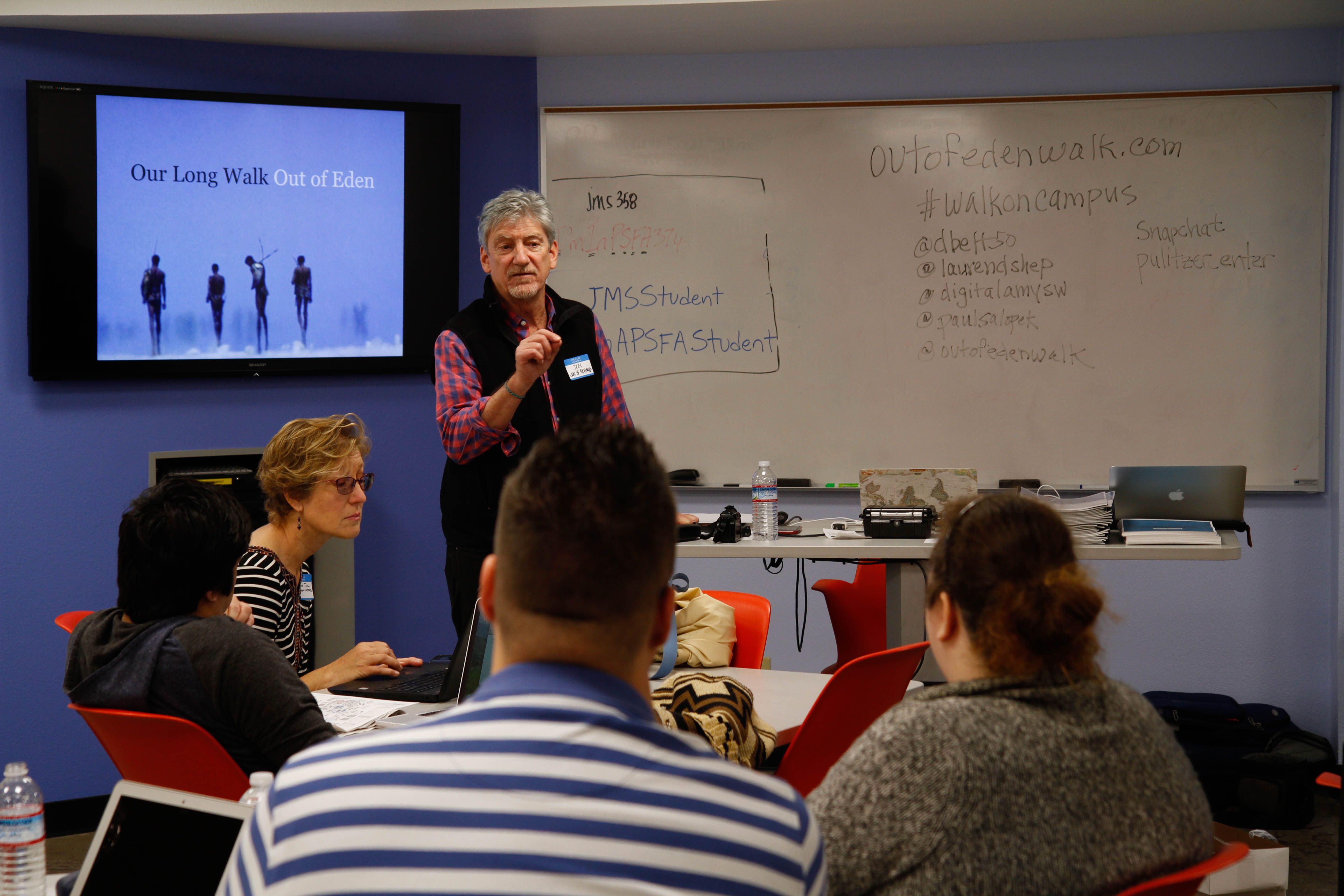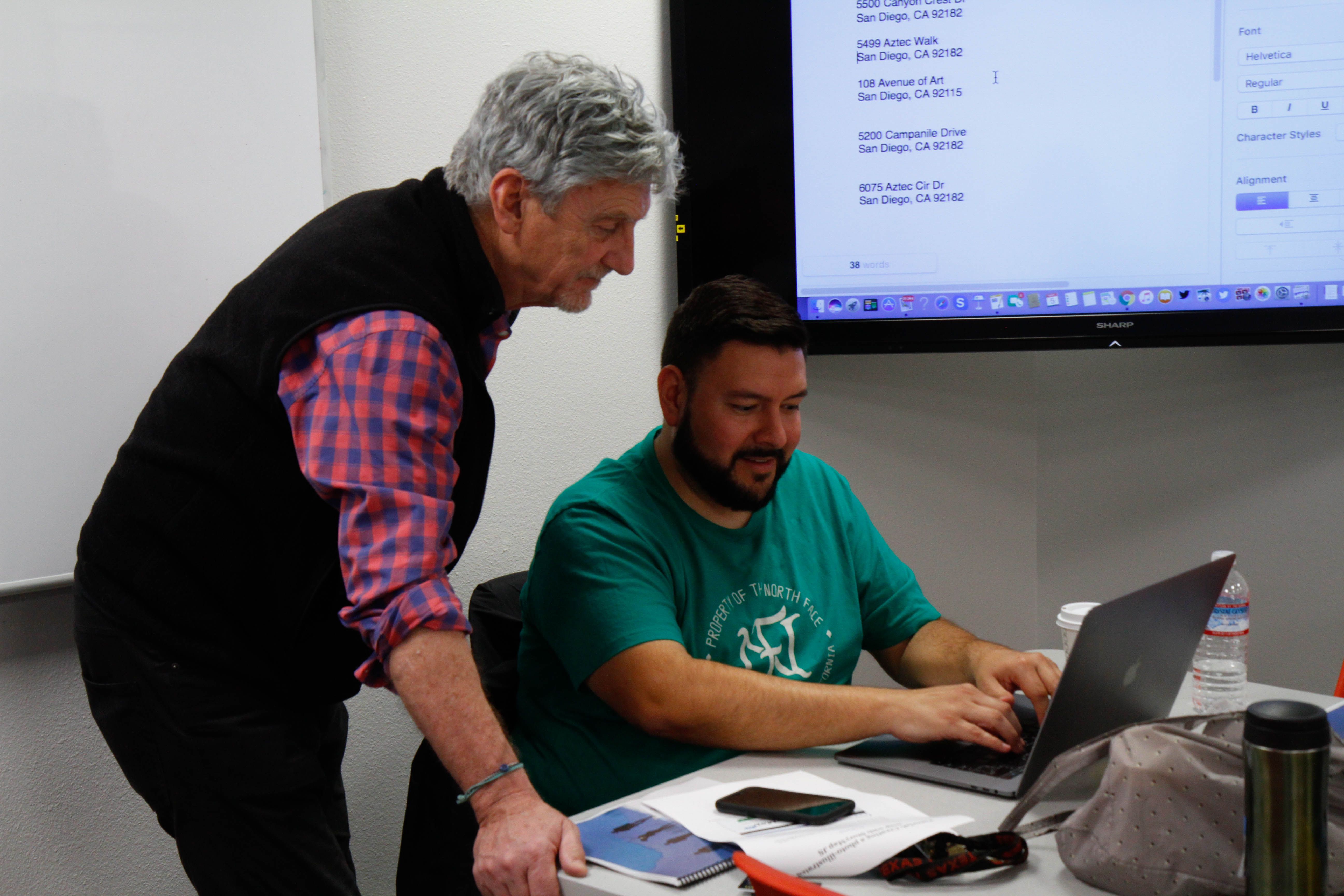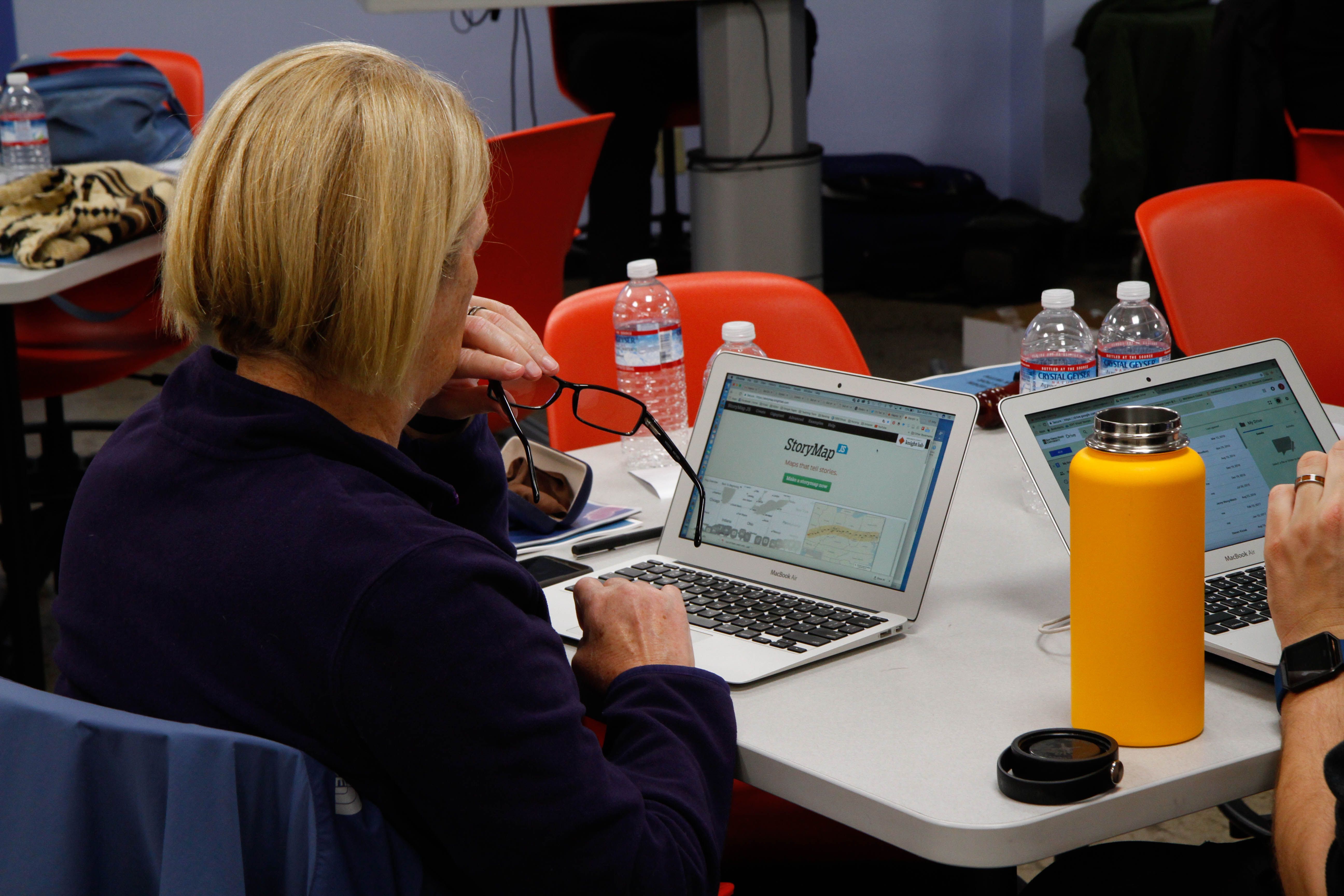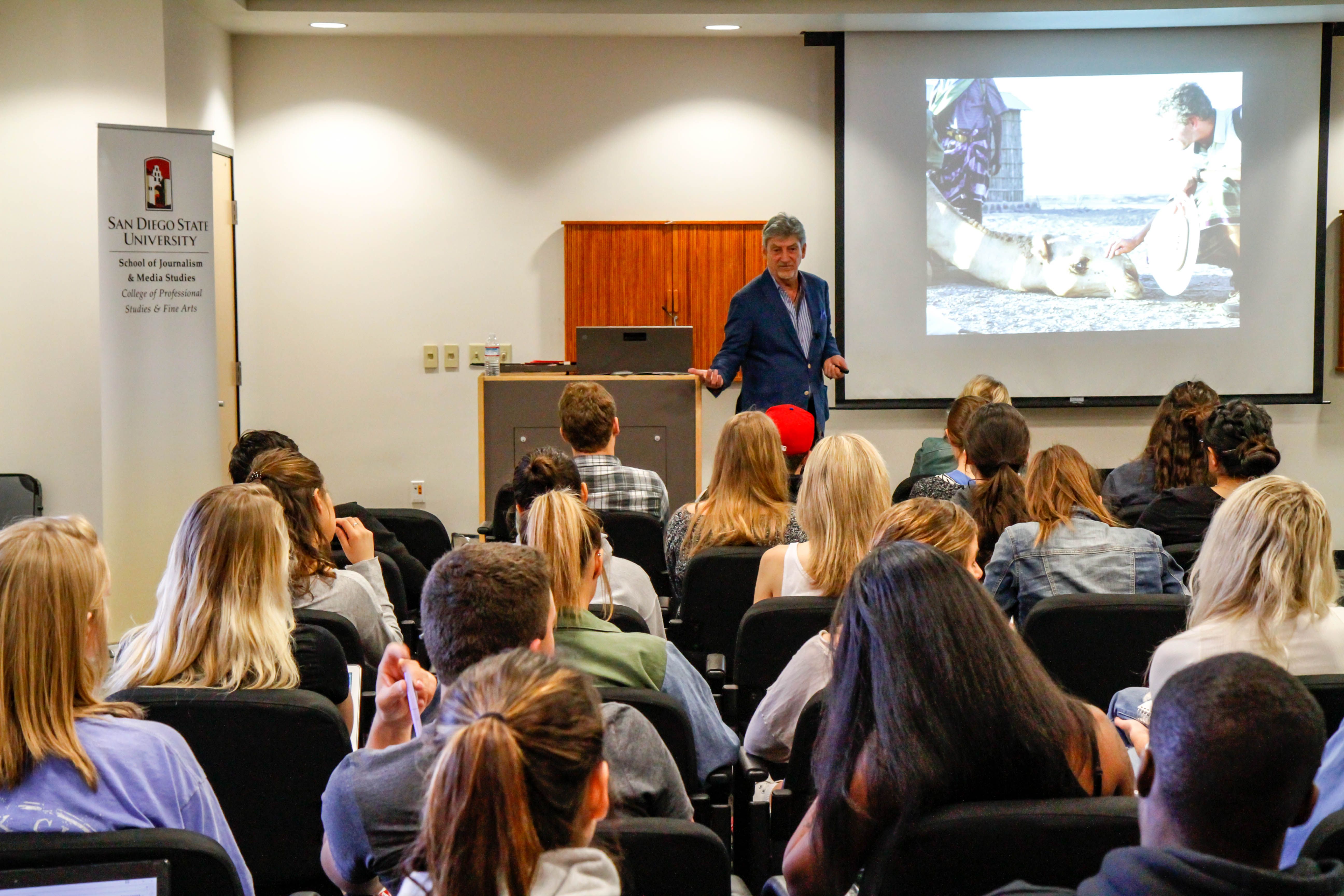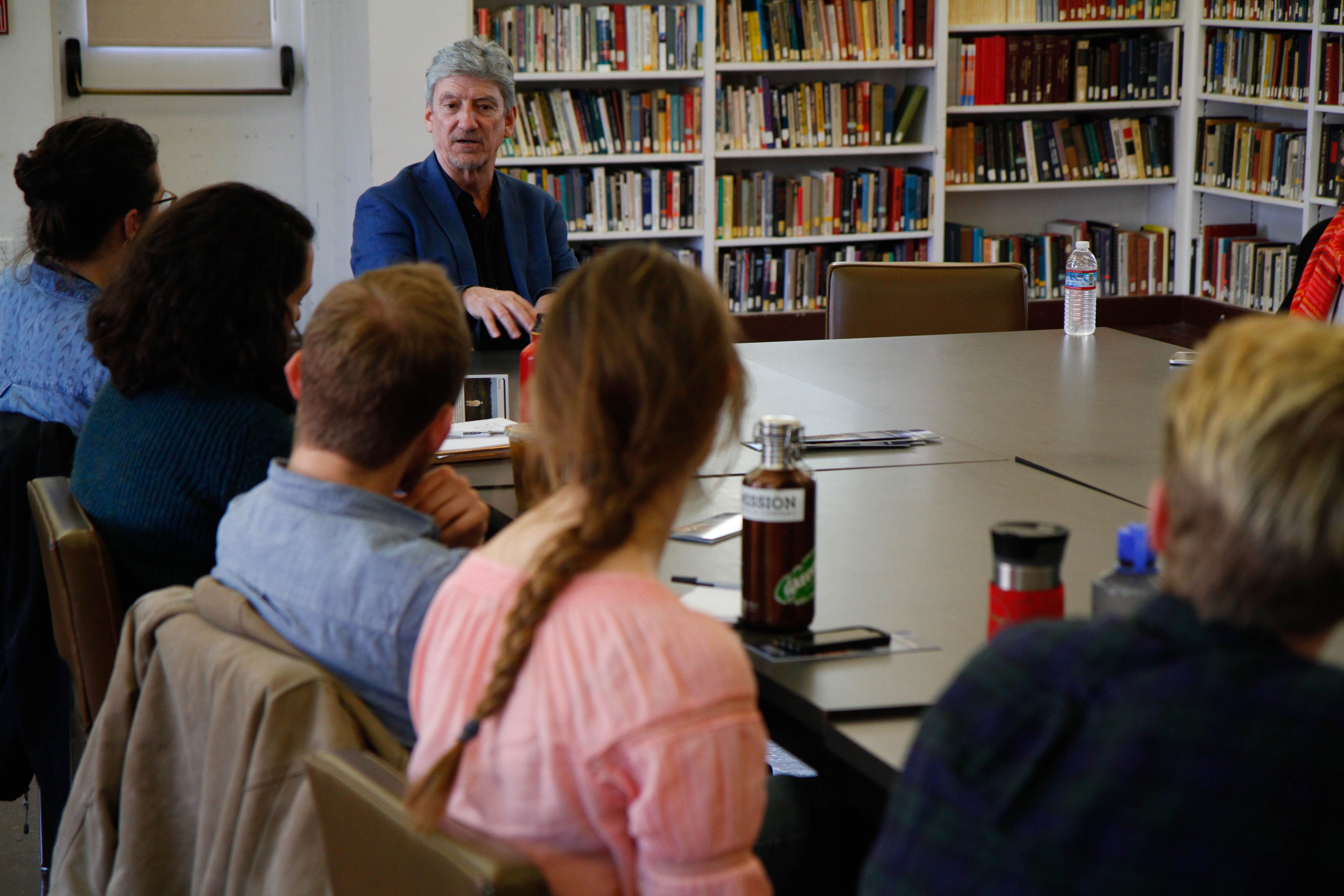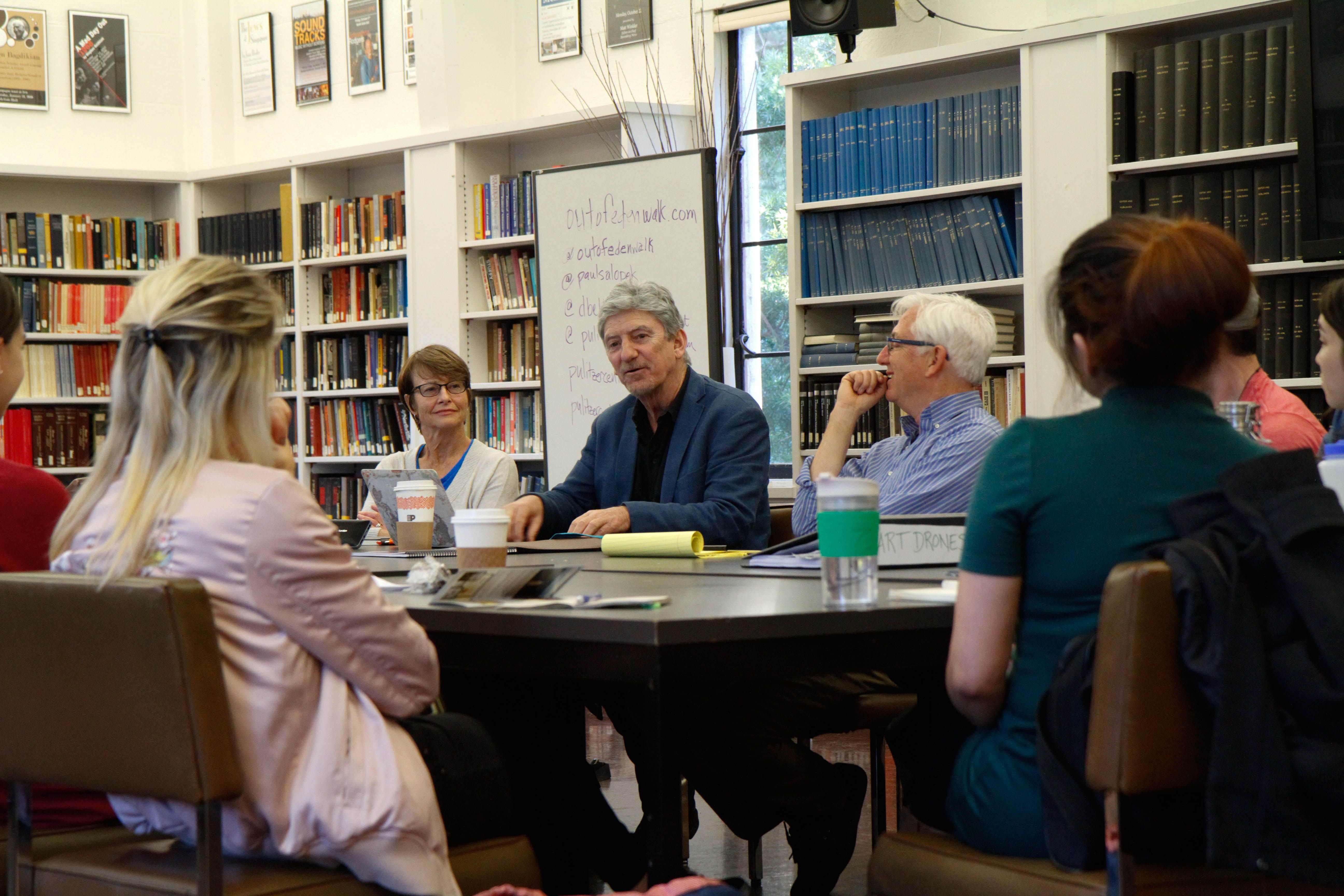“Stories define our species, and Paul is reenacting the ago-old process, developed as we explored the world over thousands of years, of becoming fully human,” Don Belt told students at the University of California, Berkeley, Graduate School of Journalism, as he introduced them to Paul Salopek and the 10-year-long Out of Eden Walk project for National Geographic. “You all have a set of tools now thanks to your training in multimedia, narrative writing, videography, photography. It’s up to you to decide which of these many tools you use to tell this particular story.”
Walking three miles an hour along the path that our ancestors trekked out of Africa 2500 generations ago, Salopek finds in the lives of ordinary people the insights into the overarching issues of our time.
In March 2017, Don Belt traveled up the California coast, teaching lessons in slow journalism through Out of Eden Walk on Campus workshops and lectures at San Diego State University and one of our new Campus Consortium members, University of California, Berkeley.
Formerly a writer and senior editor for National Geographic, Belt traveled to 80 countries over a 30-year career, helping to guide the magazine’s coverage of topics ranging from weapons of mass destruction to the legacy of colonialism in the modern Middle East. Now Belt, an adjunct professor of journalism at the University of Richmond, shares his curriculum based on Paul Salopek’s Out of Eden Walk with universities in the Pulitzer Center’s Campus Consortium and others. The Out of Eden Walk has been used in classrooms across the K-16 levels. To learn more about the evolution of Belt's Walk on Campus projects with students and educators, see his article on National Geographic's Out of Eden Walk website.
On March 5, 2017, Belt led Slow Journalism in a Digital Age, a day-long Out of Eden Walk on Campus workshop for educators at San Diego State University.
Belt introduced the wide range of academic subjects that can be supported by the Out of Eden Walk, including journalism, anthropology, archeology, environmental science, and sociology. Each of the 10 educators in the lab found a piece of the Walk on Campus curriculum that could improve engagement in their courses. Participants in the workshop included librarians in the sciences, a nursing professor, a high school geography teacher, an elementary school teacher, a faculty member in the campus diversity department, two freelance journalists, and an educator of refugees who have come to the U.S.
Also in attendance was Amy Schmitz Weiss, associate professor of journalism and media studies at San Diego State University, who partnered with Belt and the Pulitzer Center to host the Walk on Campus workshop, along with Bey-Ling Sha, director of the School of Journalism and Media Studies at San Diego State.
On March 6, 2017, Belt presented "Slow Journalism: A Storytelling Renaissance for the Digital Age," a campus-wide lecture at San Diego State University for an audience that included students, faculty, and both emerging and practicing journalists.
Picking out tools from his Out of Eden Walk on Campus Curriculum, Belt explained that the act of making a map forces us to notice the details that we would otherwise miss. Among those details can be a storytelling opportunity.
When asked how Salopek balances slow journalism with today’s social media, Belt noted that Salopek uses Twitter on the walk as a supplement to the longer stories embedded along his journey. The tweets act as microscopic looks at details in his daily life.
During a visit to professor Don Arthur’s capstone course for journalism students, Belt was asked how he decides which stories to tell.
“I choose what stories move me. What topics do I have a personal affinity for? I love places where forces are at play and where there is friction,” he said. He went on to underline the necessity of having an interest in the story if it is going to help educate, uplift, and enlighten people.
When asked how he maintains integrity and garners trust while meeting people who are affected by the issue he is reporting on, Belt responded, “Access to these people can be expedited by the person you are with, the “fixer” in a foreign environment. Also, if you come to them with humility and genuine curiosity about their way of life, you can start to view the story from the inside, looking out. People can sense if you are looking for a pre-scripted answer. Every conversation is a transaction. Listen.”
Looking for their own paths into magazine journalism, students also asked Belt how he got his start in the business.
Working construction in South Carolina in his early 20s, he took creative writing evening courses at the local university, thinking to become a poet. When an independent study project took him into Mexico and South America, Belt caught the travel bug, and realized that he enjoyed observing, and documenting people he met from local cultures. Returning home, he began freelancing for regional magazines and learned his reporting craft on the job.
Dreaming to work at National Geographic, he applied for an entry-level job writing photo captions. A turning point came when he drove from South Carolina to Washington D.C., to hand-deliver his application. By a strike of luck, he found the editor who would later hire him eating lunch at his desk, and struck up a conversation Don decided to move to Washington D.C. to be ready at a moment’s notice if he ever got an interview. He later got the job and built his career at National Geographic as a writer and editor specializing in foreign affairs.
To the students, Belt shared lessons learned along the way: “Always have the ambition to do your very best. Give editors a story that knocks their socks off. It takes a little bit of luck...and a lot of perseverance."
On March 8, 2017, Belt visited University of California, Berkeley, meeting with students in journalism and media studies. Journalism graduate students, using media that range from documentary filmmaking, narrative writing and new media, to conservation and resource studies, introduced projects they are working on.
Reporting topics ranged from the effects of climate change on coffee crops in Guatemala and fisheries in Thailand, to the impact of sea level rise on coastal regions in the Philippines. Closer to home, students are also documenting attempts to conserve resources amidst water depletion in California, and gather stories of gender expression in the Bay Area.
The question on several students' mind was what they can arm themselves with when pitching a story to an outlet.
Belt emphasized the importance of thinking visually, and demonstrating how the story can be illustrated through photography, videography, or new media. Other questions editors ask include 'What makes this story current?' and ‘What kind of shelf life will the story have?' While the hook should be current, many stories can aspire to be timeless and universal.
The rest of the day was spent in one-on-one meetings, with Belt advising graduate students on how to pitch, report, and shape the project proposals they presented to him.
"I am really impressed with the projects you've presented. Everything I've heard is a viable story idea," he said to a group of students in that evening's class.
That evening, Belt, Tim McGirk, and Cynthia Gorney met with McGirk’s journalism students to share words of wisdom from international reporting for magazines, focusing on photography and narrative nonfiction.
Most recently writing for a National Geographic multimedia project on widowhood around the world, supported by the Pulitzer Center, Gorney spent much of her career at the Washington Post, and is now a professor emeritus in the University of California, Berkeley, Graduate School of Journalism.
A former Time magazine bureau chief in south Asia and the Middle East McGirk has covered the wars in Afghanistan and Iraq, the Israeli-Palestinian conflict, and the hunt for al-Qaeda.
Belt shared stories that demonstrated the ambitious nature of a successful international journalist, taking the less traveled path, and jumping into the unknown. In one instance, he accepted the invitation of a Pakistani airline pilot to ride in the cockpit to see the land through a bird’s-eye view. He saw that Pakistan straddles two distinct terrains: a river valley plain, flat all the way to Bangladesh, that is an extension of the Indian subcontinent; and West of the Indus River, a mountainous terrain that continues all the way into Afghanistan. “From the cockpit I had this amazing tableau—looking down on a Pakistan that included both those provinces, a bifurcated kind of a country. When I reached the ground, I reached out to a cultural anthropologist and learned that Pakistani society was much the same way. I drove some 8,000 miles around Pakistan talking to every kind of person, but that plane ride gave me one of my most important insights.””
Belt, Gorney, and McGirk all stressed the importance of documenting the daily lives of people and reporting on the deeper context in which they live, material far more telling than government pronouncements and quotes from leading figures relied upon by the mass media.
Gorney offered these tips of the trade: “Try to see the world through other people’s eyes. Start with an expert who will lead you to people. The best information comes from saying, ‘I want to learn that. Can I come along?’ It is a combination of serendipity and curiosity and the realization that you are receptive to that.”
“You have to give yourself the space to detour off your roadmap. By exploring, you can think about ways weaving people’s experiences into the thread that will lead the reader through the story,” McGirk said.
“Develop a clear notion of why your story is important and where it might land, then partner with outlets that can support your international travels like the Pulitzer Center, which is constantly looking for interesting ideas,” Belt added.
Lessons that the students took away from their visit with Belt can be useful to all of us, if we are hoping to slow down and notice the treasures of life.
Travel is important. “If you are going somewhere, even on vacation, give yourself an assignment,” says Belt. “Force yourself to take one day of that experience and do some reporting. Get out and take a walk. See what you find. Look for stories in the little things in your environment. Read the local paper, and raise your awareness so you're not walking around blind. Use your multimedia skills and just have fun with it. I spent a lot of time working on the craft, trying to put on paper what everyday experience meant."
For people who still want to explore but who do not have the opportunity to travel on whim, Belt recommends walking around a place you know and finding something new.
“You'd be surprised what you find when you put on your Paul Salopek hat. We are surrounded by stories in our everyday activities."
Read more from Belt about slow journalism educational opportunities in his article for National Geographic's Out of Eden Walk website.
